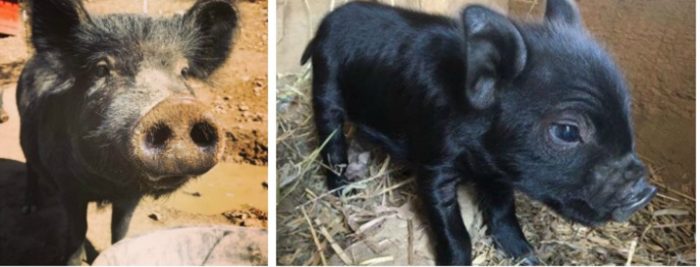Like I said previously these hogs are great to have around! They simply love attention and are super easy to handle as they are known for being very docile creatures. Oh, and there is never a need to worry about being in short supply as they are prolific breeders. In fact, if you have 3 females and 1 boar chances are within a year you will have more than a dozen little ones running around. Just be sure to manage their weight because while they may not be picky eaters they are pigs and can/will over eat and any pig who is too big ca suffer from fertility issues.
We have been blessed on our homestead by being able to partner with nearby organic farmers who will allow us to have their produce that may be unable to be sold because it’s not quite perfect, or slightly wilted, or overharvested. We also add our own table scraps, fermented vegetables, and plenty of leftover milk whey from our own raw milk after we separate the cream and make butter and cheese. In addition, especially in the winter months when their pasture lies dormant, we provide a premixed, non-GMO, soy-free feed for them. AGH eat roughly 4 percent of their weight daily, for instance, a 150-pound pig will require 5 to 6 pounds of high-calorie feed each day. Each pig needs 3 to 5 gallons of clean, fresh water daily. Lactating sows will need an additional 1 to 2 gallons each day.
Pastured Pork, Lard, and Charcuterie Production
These AGH provide excellent pastured pork. Pastured AGH have meat with a beautiful, earthy flavor. Their meat has higher levels of omega-3 fats, which are essential for us human caretakers. Chefs and charcuterie artists prefer to cook with this breed.
Most heritage AGH breeders believe it is the genetics that make the meat taste so good. The marbling, and intramuscular fat hasn’t been bred out of these special hogs. However, the taste comes largely from the way they are raised. If raised slowly, outdoors on great free range pasture, they are getting exercise, finding minerals in the soil, and enjoying fresh air and clean water. They are living without stress, and that all adds up to wonderful, flavorful meat.
Butchering and Processing
Butchering is easiest in winter, and may influence at what age you butcher. At 6 months of age you probably have a pig weighing about 60 pounds, with a 50 percent carcass weight. By 1 year of age, your pig probably weighs about 120 pounds, with 60 pounds of carcass. AGH reach their full size at about 2 to 3 years of age, topping out at 200 to 300 pounds.
One thing that is important to know – you don't have to do the butchering yourself if you don't want to. We send our larger livestock (cows, pigs, sheep) off to be butchered and processed. It's something we have decided to do for right now since we are raising so many different types of animals and we find it easier for someone else to do this job for us.
If you do decide to do this, just talk to your meat processor and make sure they know how to work with American Guinea Hog meat. Make sure you save all the bones and organs and get all the fatback so you can make lard. AGH are considered a “lard breed” because they have an exceptional amount of lard on their bodies.
And if you do want some charcuterie cuts, make sure you discuss that with them too.
Thanks to our friends over at The Paleo Mama for sharing their experiences with us!

Rich Nation
Buddy pretty much had them covered
Charles Bernard
Only if you have solid fences and big pastures. They can be incredibly destructive just like the bigger hogs.
We love ours
Travis Renaud
Mary Ellen Carder
Bacon!!!
Joanne Marklund
Think we can get some?
Lana Plants Conrad